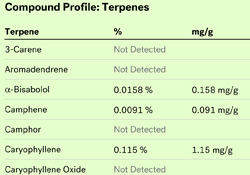I received some questions from a reader today that are certainly great questions. The questions are in reference to terpenes and a previous post, Terpenes as Additives in Cannabis Products. Here goes:
Great article! As someone who is interested in the many health benefits of terpenes, there is almost no information online for how to be safe consuming them. To the extent that you’re looking for more topics for the blog, I’d personally love to know more about:
1) How the same terpene from the original plant (myrcene from cannabis, for instance) differs from the food /edible grade terpenes people sell? I struggle with this, because they would seem to be chemically the same compound.
2) People ingest terpenes in THC/CBD oils, when they smoke and when they drink hoppy beer. Presumably, ingesting them (properly diluted and dosed) is not a problem. How would someone go about arriving at the proper dilution? Meaning, how would you replicate the level / ratio of myrcene or limonene from a smoked product when you’re dealing with a terpene in oil form and a carrier oil?
3) Just an explanation on the math behind terpene ratios. You cited the relative percentages of terpenes in a hemp oil. But, I really don’t understand how to wrap my mind around those numbers. For instance, it would be helpful to know that there are roughly X (ml or microliters) of hemp essential oil in a 1 gram joint. That would put the terpene percentages into something tangible.
Just some thoughts from someone who loved this post and the topic.
Thanks so much!
. . . . . . . .
1. Terpenes work in synergy with each other as well as with the cannabinoids and other plant constituents present. By isolating them and adding them to something else you are breaking the synergy and don’t get the benefit of whole plant medicine. Yes, the molecules are the same – they are the same no matter where they come from, but they don’t have their sibling terpenes to act with and the results may not be the same.
You can take citric acid out of a lemon, but will it be of the same benefit of the whole lemon itself? In some applications it will suffice, but in others it won’t. Would you make lemonade with citric acid and add flavors to make it seem more like lemonade, or just use the lemons?
2. Ingesting terpenes is safe most of the time. Some are definitely not safe for human consumption. Some cause skin issues, some are abortifacient, and the list goes on. While essential oils have been well researched, individual isolated terpenes haven’t been in use the way they are now, (smoking/vaping), for very long so there isn’t much research in this area. If you are utilizing them in their isolated form, how much to use is variable depending on what you are using them for.
I know from watching my husband brew beer that changing the hoppy flavor of the brew is done by adding different kinds of hops. I have never heard of a brewer using just the terpenes isolated from hops as a flavor changers. It could be so but seems unlikely.
3. I wasn’t speaking about percentages of hemp oil, but rather hemp essential oil, and it is certainly variable and every strain will be different. The math is difficult for me too – I’ve never been good at it, LOL. As a joint goes you would be using milligrams rather than milliliters. However, if you are getting your cannabis tested at a facility that can measure terpene content, they will give you numbers that you can use. (Click this for test results. SteepHill-GrapeBlueberryGSC-terpenes). The results show how many milligrams of the terpenes present are in a gram of the sample plant matter. You can take it from there.
Thanks for your interest! I love this subject too.
Cannagramma

thanks for long interesting comment Sarijuana